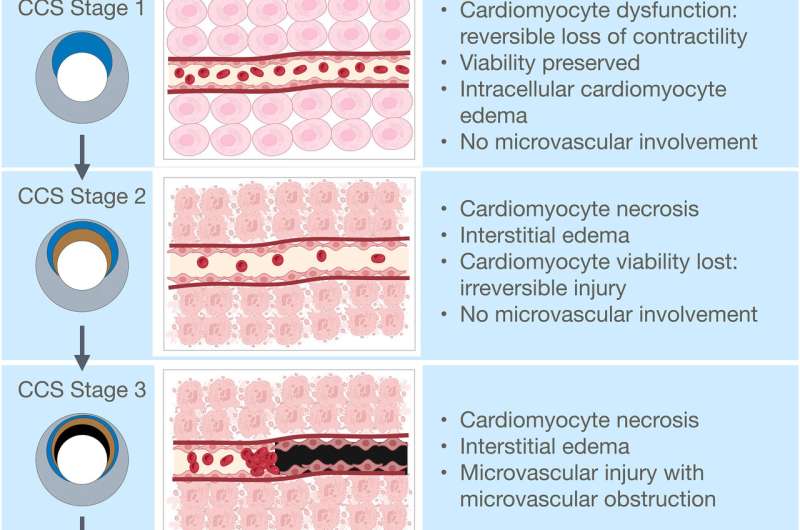This article has been reviewed according to Science X's editorial process and policies. Editors have highlighted the following attributes while ensuring the content's credibility:
fact-checked
peer-reviewed publication
trusted source
proofread
New statement presents first clinical classification of heart attacks based on tissue damage

The Canadian Cardiovascular Society (CCS) has released the world's first classification of acute myocardial infarction (AMI), or heart attack, based on heart tissue damage research that was driven by two cardiovascular investigators within the Ischemic Heart Disease Program of Krannert Cardiovascular Research Center (KCVRC) at Indiana University School of Medicine and Northern Ontario School of Medicine.
The four-stage classification, CCS-AMI, was presented at the Vascular 2023 conference on Oct. 29 in Montréal, Canada, and published in the Canadian Journal of Cardiology With more than two decades of experience in myocardial infarction research, KCVRC Executive Director Rohan Dharmakumar, Ph.D. and immediate past Chief of Cardiology and physician scientist Andreas Kumar, MD, from Northern Ontario School of Medicine, conceptualized the classification.
The CCS-AMI Writing Group, which included an expert panel of cardiovascular specialists primarily from Canada and KCVRC physician scientist Keyur Vora, MD, FACC, worked with Dharmakumar and Kumar to develop the rationale and framework for the CCS-AMI Classification. The CCS-AMI Writing Group was endorsed by the CCS, chaired by Kumar and co-chaired by Dharmakumar and Michelle Graham, MD, president of CCS.
Clinical classifications are reviewed and developed by medical societies to introduce and adopt new standards of care and evolving guidelines. Knowing what level of tissue damage has occurred on the heart muscle can help cardiologists determine how best to redirect care to prevent a patient case from escalating, even with treatments available today.
CCS classifications have a rich history in cardiovascular care. CCS-AMI classification arrives nearly 50 years after the establishment of the CCS-Angina classification in 1972, which is widely used around the world to assess chest pain. Unlike CCS-Angina, which is based on clinical parameters, CCS-AMI uses a hybrid of clinical data and pathophysiology of heart muscle damage to characterize the level of injury following AMI.
Authors of the consensus paper say a classification that includes tissue-level changes is needed to leverage the "predictive power" of tissue damage to improve research and develop tissue-directed therapies for each stage.
"What we've learned over the past decade using advanced imaging is that when you open a blocked blood vessel of the heart, it can at times lead to substantially more tissue damage. On some patients, this can drive electrical instabilities (arrhythmias) or ventricular remodeling that can then lead to heart failure, hospitalization or death," said Dharmakumar.
"In manuscripts we published in 2022, we demonstrated that when there is a rupture of small vessels, which we call intramyocardial hemorrhage, it results in a vast number of cardiomyocytes dying that would otherwise have been saved by reperfusion therapy. We also show that when reperfusion therapy results in intramyocardial hemorrhage, the damaged area can be replaced by fatty tissue, weakening the heart and directing it towards heart failure," Dharmakumar continued.
The CCS-AMI Classification outlines damage to the heart muscle following a heart attack in four progressively severe stages based on decades of research:
- CCS Stage 1 Myocardial Infarction: Aborted Myocardial Infarction
- CCS Stage 2 Myocardial Infarction: Cardiomyocyte necrosis without microvascular injury
- CCS Stage 3 Myocardial Infarction: Cardiomyocyte necrosis and microvascular obstruction
- CCS Stage 4 Acute Myocardial Infarction: Cardiomyocyte necrosis, microvascular obstruction and reperfusion hemorrhage
"The last two stages are directly associated with reperfusion injury and extensive tissue damage," Dharmakumar said. "This classification establishes the crucial framework needed, so new therapies can be developed to maximize impact on patient outcomes. I am hopeful that CCS-AMI Classification will spur on new guidelines by various cardiovascular societies around the world, so cardiovascular patients everywhere can benefit from more tailored interventional cardiac care."
Vora, who presented clinical cases to explore the diverse characteristics exhibited by Acute MI patients during the CCS-AMI Classification session at Vascular 2023, explains that we now have a better understanding of myocardial infarction from the nature of the tissue injury following reperfusion.
"CCS-AMI Classification will drive new diagnostic and therapeutic clinical trialS to save patients suffering from CCS classifications of severe injury," Vora said.
Kumar stated the classification is a game-changing tool that opens new avenues for patient risk assessment and future drug development in an easy, usable format.
"Not all heart attacks are the same," Kumar said. "Patient risk assessment and future therapies will improve when the precise stage of tissue injury is considered."
More information: Andreas Kumar et al, The Canadian Cardiovascular Society Classification of Acute Atherothrombotic Myocardial Infarction Based on Stages of Tissue Injury Severity: An Expert Consensus Statement, Canadian Journal of Cardiology (2023). DOI: 10.1016/j.cjca.2023.09.020





















